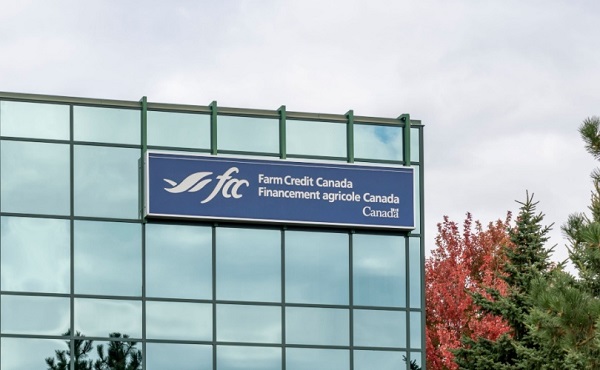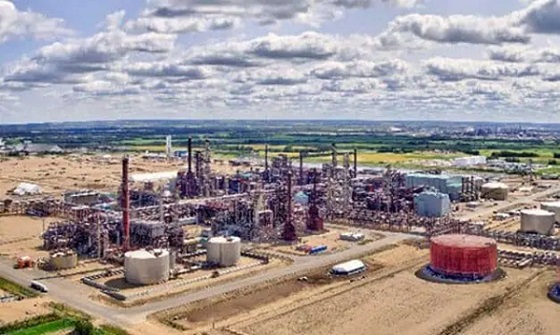Agriculture
Red Deer Ag Innovator joins leading Ag company DOT Technology Corp

From DOT Technology Corp.
Agri-Trend founder to bridge farming and technology gap and lead large-scale global commercialization of autonomous Dot Power Platform for agriculture.

DOT Power Platform
EMERALD PARK, SASK.
Dot owner and founder Norbert Beaujot is pleased to announce the addition of agricultural technology expert Robert Saik to the Dot Technology Corp. leadership team. As Chief Executive Officer of Dot Ready Retail (DRR), Saik will work with farmers in Canada and globally to establish a retail and distribution system to support autonomous farming.
“Given Rob’s vast experience in the agriculture industry and his record as an agri-business thought leader, he brings a unique set of skills to help grow the Dot Power Platform by connecting agronomics with data and robotics.” said Beaujot. “The way producers buy farm equipment has evolved. His mandate is to work with farmers to better understand their decision making when it comes to purchasing new equipment and how they want to be supported in today’s high technological agricultural market.”
Robert, a veteran entrepreneur and Distinguished Agrologist has founded many agricultural ventures. Most recently he completed the sale of Agri-Trend and Agri-Data to Trimble. He is passionate about farming with an interest in an operation in Uganda and facilitates the PowerFARM peer group for farmers. As consultant, speaker, author, filmmaker and outspoken advocate for agriculture, Robert always has had his eye to the future of farming. He has published over 50 articles on crop agronomics and is a thought leader on the integration of technology in crop production. His book, The Agriculture Manifesto was recognized as a “Best of Amazon Book” and in 2014, he was awarded the Canadian Agri-Marketer of the Year by the Canadian Agri-Marketing Association. Last fall it was announced that the Dot Power Platform would be available for sale in select regions of Saskatchewan and Alberta throughout 2019. To prepare market demand of Dot and Dot Ready Implements, Saik will lead DRR to help bridge the farming and technology gap for new generations of farmers.
“Autonomous farming through the Dot Power Platform opens up an opportunity to engage a whole new generation in farming. With labour being a major constraint on many farms, the evolution to autonomous operations makes sense and will bring a renewed interest from young people looking to pursue careers in agriculture,” Saik explained. “As we develop a global retail network for Dot, we are looking to bring together technology with people to create a new type of sustainable and profitable arable farming.”
Standardized autonomous ‘power units’ have the ability to complete limitless tasks for farmers while freeing their time for higher level tasks. The Dot Power Platform is a mobile diesel-powered platform designed to handle a large variety of implements commonly used in agriculture, mining and construction. Working for farmers, Dot completes tasks autonomously and enables farmers to spend more of their time focusing on the overall operation of their farms.
About Dot Technology Corp.
Dot Technology Corp, established in 2017, is a technology company that manufacturers Dot, a patented autonomous diesel-powered platform, in Saskatchewan.
Agriculture
Health Canada pauses plan to sell unlabeled cloned meat

From LifeSiteNews
Health Canada has indefinitely paused its plan to allow unlabeled cloned meat in grocery stores after thousands of Canadians, prominent figures, and industry leaders condemned the move.
Health Canada is pausing its plan to put unlabeled cloned meat in Canadian grocery stores, following public outcry.
In a November 19 update on its website, Health Canada announced an indefinite suspension of the decision to remove labels from cloned meat products after thousands of Canadians condemned the plan online.
“The Government of Canada has received significant input from both consumers and industry about the implications of this potential policy update,” the publication read. “The Department has therefore indefinitely paused the policy update to provide time for further discussions and consideration,” it continued, adding, “Until the policy is updated, foods made from cloned cattle and swine will remain subject to the novel food assessment.”
In late October, Health Canada quietly approved removing labels from foods derived from somatic cell nuclear transfer (SCNT) clones and their offspring. As a result, Canadians buying meat from the grocery store would have had no way of knowing if the product was cloned meat.
Many researchers have documented high rates of cloning failure, large offspring syndrome (LOS), placental abnormalities, early death, and organ defects in cloned animals. The animals are also administered heavy doses of antibiotics due to infections and immune issues.
Typically, the offspring of cloned animals, rather than the cloned animals themselves, are processed for human consumption. As a result, researchers allege that the health defects and high drug use does not affect the final product.
However, there are no comprehensive human studies on the effects of eating cloned meat, meaning that the side-effects for humans are unknown.
News of the plan spread quickly on social media, with thousands of Canadians condemning the plan and promising to switch to local meat providers.
“By authorizing the sale of meat from cloned animals without mandatory labeling or a formal public announcement, Health Canada risks repeating a familiar and costly failure in risk communication. Deeply disappointing,” food policy expert and professor at Dalhousie University Sylvain Charlebois wrote on X.
"By authorizing the sale of meat from cloned animals without mandatory labeling or a formal public announcement, Health Canada risks repeating a familiar and costly failure in risk communication. Deeply disappointing."
More on this week's Food Professor Podcast! https://t.co/UZTIcQzUN3
— The Food Professor (@FoodProfessor) October 30, 2025
Likewise, Conservative MP Leslyn Lewis warned, “Health Canada recently decided that meat from cloned animals and their offspring no longer needs a special review or any form of disclosure.”
“That means, soon you could buy beef or pork and have no idea how it was bred,” she continued. “Other countries debate this openly: the EU has considered strict labelling, and even the U.S. has admitted that cloned-offspring meat is circulating.”
“But here in Canada, the public wasn’t even told. This is about informed choice,” Lewis declared. “If government and industry don’t have to tell us when meat comes from cloned animals, then Canadians need to ask a simple, honest question: What else are we not being told?”
Health Canada recently decided that meat from cloned animals and their offspring no longer needs a special review or any form of disclosure. That means, soon you could buy beef or pork and have no idea how it was bred.
Other countries debate this openly: the EU has considered… pic.twitter.com/zCnqJOpvf3
— Dr. Leslyn Lewis (@LeslynLewis) November 14, 2025
Likewise, duBreton, a leading North American supplier of organic pork based out of Quebec, denounced the move, saying, “Canadians expect clarity, transparency, and meaningful consultation on issues that directly touch their food supply. As producers, we consider it our responsibility and believe our governing food authorities should too.”
According to a survey conducted by duBreton, 74 percent of Canadians believe that “cloned meat and genetic editing practices have no place in farm and food systems.”
Agriculture
Federal cabinet calls for Canadian bank used primarily by white farmers to be more diverse

From LifeSiteNews
A finance department review suggested women, youth, Indigenous, LGBTQ, Black and racialized entrepreneurs are underserved by Farm Credit Canada.
The Cabinet of Prime Minister Mark Carney said in a note that a Canadian Crown bank mostly used by farmers is too “white” and not diverse enough in its lending to “traditionally underrepresented groups” such as LGBT minorities.
Farm Credit Canada Regina, in Saskatchewan, is used by thousands of farmers, yet federal cabinet overseers claim its loan portfolio needs greater diversity.
The finance department note, which aims to make amendments to the Farm Credit Canada Act, claims that agriculture is “predominantly older white men.”
Proposed changes to the Act mean the government will mandate “regular legislative reviews to ensure alignment with the needs of the agriculture and agri-food sector.”
“Farm operators are predominantly older white men and farm families tend to have higher average incomes compared to all Canadians,” the note reads.
“Traditionally underrepresented groups such as women, youth, Indigenous, LGBTQ, and Black and racialized entrepreneurs may particularly benefit from regular legislative reviews to better enable Farm Credit Canada to align its activities with their specific needs.”
The text includes no legal amendment, and the finance department did not say why it was brought forward or who asked for the changes.
Canadian census data shows that there are only 590,710 farmers and their families, a number that keeps going down. The average farmer is a 55-year-old male and predominantly Christian, either Catholic or from the United Church.
Data shows that 6.9 percent of farmers are immigrants, with about 3.7 percent being “from racialized groups.”
National census data from 2021 indicates that about four percent of Canadians say they are LGBT; however, those who are farmers is not stated.
Historically, most farmers in Canada are multi-generational descendants of Christian/Catholic Europeans who came to Canada in the mid to late 1800s, mainly from the United Kingdom, Ireland, Ukraine, Russia, Italy, Poland, the Netherlands, Germany, and France.
-

 Alberta2 days ago
Alberta2 days agoCarney’s pipeline deal hits a wall in B.C.
-

 Alberta2 days ago
Alberta2 days agoAlberta Sports Hall of Fame Announces Class of 2026 Inductees
-

 Censorship Industrial Complex2 days ago
Censorship Industrial Complex2 days agoConservative MP Leslyn Lewis slams Liberal plan targeting religious exemption in hate speech bil
-

 Energy2 days ago
Energy2 days agoCanada following Europe’s stumble by ignoring energy reality
-

 Business2 days ago
Business2 days agoCanada’s climate agenda hit business hard but barely cut emissions
-

 Bruce Dowbiggin1 day ago
Bruce Dowbiggin1 day agoIntegration Or Indignation: Whose Strategy Worked Best Against Trump?
-

 Health1 day ago
Health1 day agoNews RFK Jr.’s vaccine committee to vote on ending Hepatitis B shot recommendation for newborns
-

 International1 day ago
International1 day agoFBI may have finally nabbed the Jan. 6 pipe bomber






